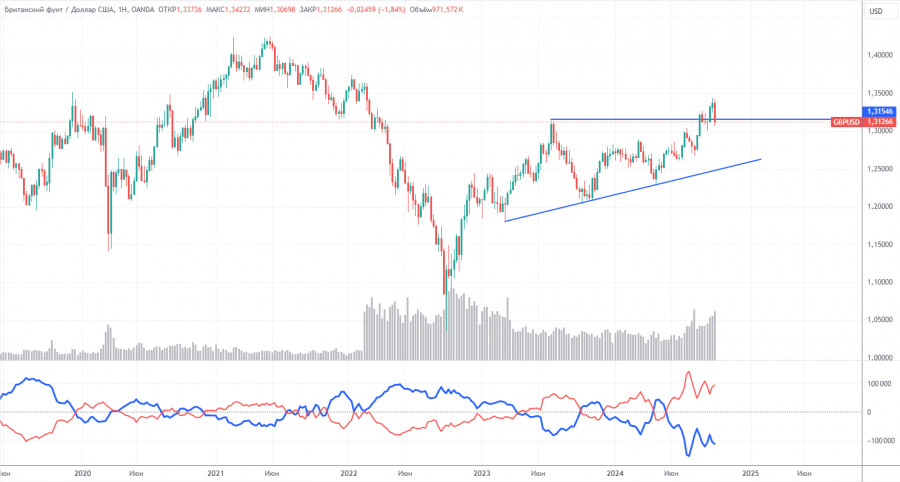Analysis of GBP/USD 5M

The GBP/USD currency pair sustained its decline on Tuesday without even attempting to start a correction. Yesterday, the UK released its inflation report for September, and all the figures came in below forecasts. What does this mean? Simply put, inflation is falling faster than Andrew Bailey feared. Moreover, the core inflation rate is now at 1.7%. We previously mentioned that the Bank of England might be concerned about core inflation and inflation in the services sector. However, the central bank cannot ignore the drop in headline inflation. If the BoE waits for problem areas of inflation to decrease by another 1.0–1.5%, headline inflation, and inflation in the manufacturing sector could reach zero or even negative levels. And how do you balance all types of inflation, then?
We believe the BoE needs to lower rates as quickly as possible, perhaps even in 0.5% steps. It seems the market also understands this, having long praised the resilience of the British economy during challenging monetary times. However, the UK economy has grown only for appearance's sake, and inflation is rapidly approaching zero. It looks like the BoE has delayed easing monetary policy as well. So, the fact that the pound is falling doesn't surprise us. We believe that the fair value of the pound against the U.S. dollar is around $1.20.
Yesterday, two trading signals were formed in the 5-minute time frame. First, the pair broke below the Kijun-sen line and the 1.3050 level, though technically, this signal was complex to capitalize on. The pound should have been sold immediately after the inflation report was released, as it didn't suggest any other course of action. Later, the price bounced off the 1.2981-1.2987 area, allowing for long positions to be opened. Both trades ended in profit.
COT Report:

The COT (Commitment of Traders) reports for the British pound show that commercial traders' sentiment has been constantly changing over recent years. The red and blue lines, representing the net positions of commercial and non-commercial traders, frequently cross and are primarily near the zero mark. We also see that the latest downward trend occurred when the red line was below the zero mark. The red line is above zero, and the price has broken through the important 1.3154 level.
According to the latest COT report on the British pound, the non-commercial group opened 6,100 new BUY contracts and closed 600 SELL contracts. As a result, the net position of non-commercial traders increased by 6,700 contracts over the week. The British pound continues to be bought up by market participants...
The fundamental backdrop still does not justify long-term purchases of the British pound, and the currency has a real chance of resuming a global downward trend. However, on the weekly time frame, we have an ascending trend line, so until it is broken, we cannot expect a long-term decline in the pound. The pound has been rising despite almost everything, and even when COT reports show that large players are selling it, it still rises.
Analysis of GBP/USD 1H

The GBP/USD pair continues to decline in the hourly time frame. The upward trend has been canceled, and now only a significant and prolonged fall of the British currency should be expected. Of course, the market might resume unjustified purchases of the British pound, but let's reiterate—there are no fundamental or macroeconomic reasons for such actions. Therefore, we continue to support the downward movement, but the pair may correct upward in the near future. For this to happen, the price must at least consolidate above the trendline.
For October 17, we highlight the following important levels: 1.2796-1.2816, 1.2863, 1.2981-1.2987, 1.3050, 1.3119, 1.3175, 1.3222, 1.3273, 1.3367, and 1.3439. The Senkou Span B line (1.3205) and the Kijun-sen line (1.3040) can also serve as signal sources. It is recommended to place the Stop Loss at break even when the price moves 20 pips in the intended direction. The Ichimoku indicator lines may shift throughout the day, so this should be considered when determining trading signals.
No important reports are scheduled in the UK on Wednesday, while three minor reports will be released in the US. Industrial production and retail sales can be given attention, but these data are unlikely to provoke a strong market reaction.
Explanation of Illustrations:
Support and Resistance Levels: Thick red lines near which price movement may end. They are not sources of trading signals.
Kijun-sen and Senkou Span B Lines: Ichimoku indicator lines transferred to the hourly time frame from the 4-hour chart. They are strong lines.
Extremes Levels: Thin red lines from which the price has previously bounced. They serve as sources of trading signals.
Yellow Lines: Trend lines, trend channels, and any other technical patterns.
Indicator 1 on COT charts: The size of the net position for each category of traders.
The material has been provided by InstaForex Company - www.instaforex.com #














 Download NOW!
Download NOW!
No comments:
Post a Comment